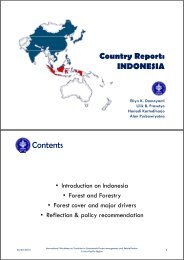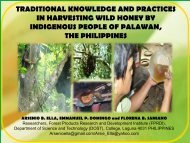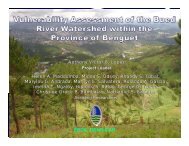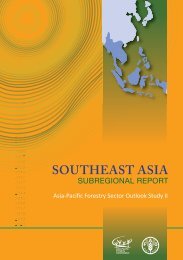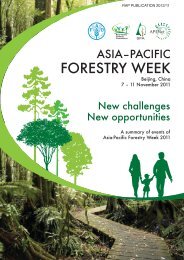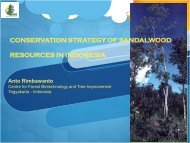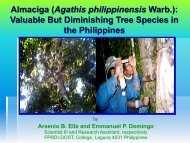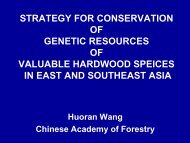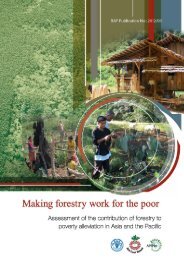Community guidelines for accessing forestry voluntary carbon ... - FAO
Community guidelines for accessing forestry voluntary carbon ... - FAO
Community guidelines for accessing forestry voluntary carbon ... - FAO
You also want an ePaper? Increase the reach of your titles
YUMPU automatically turns print PDFs into web optimized ePapers that Google loves.
Background in<strong>for</strong>mation<br />
products. Forest owners and managers can accelerate this process by<br />
managing and conserving existing <strong>for</strong>est areas, or by creating new ones.<br />
If they can prove how much <strong>carbon</strong> has been stored as a result of their<br />
ef<strong>for</strong>ts, they may claim ‘<strong>carbon</strong> credits’ based on this amount. The<br />
<strong>carbon</strong> market facilitates the trade in <strong>carbon</strong> credits, which generates<br />
resources to invest in the <strong>for</strong>estry sector.<br />
There are two <strong>carbon</strong> markets: the regulated (or compliance) market<br />
and the <strong>voluntary</strong> market. The <strong>for</strong>mer is related to activities that are<br />
taking place under international negotiations through the United<br />
Nations Framework Convention on Climate Change (UNFCCC), whilst<br />
the latter is a market evolving on a <strong>voluntary</strong> basis, mainly driven by<br />
the private sector and consumer interest. These <strong>guidelines</strong> are aimed<br />
at <strong>for</strong>estry projects that are initiated, on a <strong>voluntary</strong> basis, to generate<br />
<strong>carbon</strong> credits, whilst at the same time improving local livelihoods and<br />
enhancing the environmental services provided by <strong>for</strong>ests.<br />
The Voluntary Carbon Market (VCM) helps to reward these positive<br />
actions. It is not a single entity, but covers all the mechanisms that facilitate<br />
the trade in <strong>carbon</strong> credits which are not generated <strong>for</strong> compliance<br />
purposes. A <strong>for</strong>estry VCM project implements specific <strong>for</strong>estry activities<br />
which result in a net uptake of <strong>carbon</strong> into <strong>for</strong>est biomass, soil, and<br />
timber products, and there<strong>for</strong>e, a reduction of CO₂ emissions, and those<br />
of other greenhouse gases (GHGs), into the atmosphere. The net quantity<br />
of <strong>carbon</strong> uptake and/or emission reductions (hereafter referred to as<br />
<strong>carbon</strong> benefits) is measured and turned into <strong>carbon</strong> credits that can be<br />
marketed through various mechanisms or markets, or be sold directly to<br />
buyers or investors.<br />
The VCM supports different kinds of activities in the <strong>for</strong>estry sector,<br />
including the protection of <strong>for</strong>ests, improving <strong>for</strong>est management,<br />
planting trees on non-<strong>for</strong>est land, and the rehabilitation of degraded<br />
<strong>for</strong>ests and <strong>for</strong>est areas. These are all very different activities, and there<br />
are different standards and methods to account <strong>for</strong> the emissions and<br />
removals associated with these activities. These are described in more<br />
detail in Chapter 3.<br />
3




